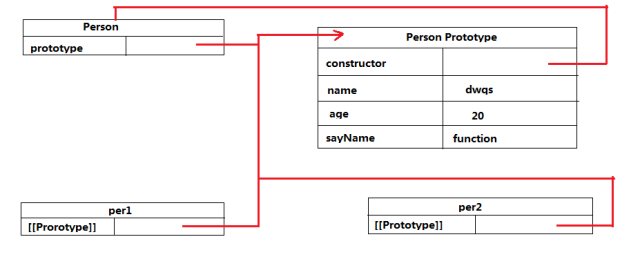
データ型
JavaScript では、データ型は 2 つのカテゴリに分類されます:
プリミティブ型: true、5 などの単純なデータを保存します。 JavaScript には 5 つのプリミティブ型があります:
●boolean: ブール値、値は true または false
●number: 数値、値は任意の整数または浮動小数点値です
●string: 文字列、値は単一で表されますquotes または double 引用符で囲まれた 1 つの文字または連続した文字 (JavaScript は文字の種類を区別しません)
●null: 値が 1 つだけある空の型: nullll
●unknown: 未定義、値が 1 つだけある: unknown
var name = "Pomy"; var blog = "http://www.ido321.com"; var age = 22; alert(typeof blog); //"string" alert(typeof age); //"number"
original 型の値は変数に直接格納されており、typeof を使用して検出できます。ただし、typeof による null の検出は、null ではなくオブジェクトを返します:
//弹出Not null
if(typeof null){
alert("Not null");
}else{
alert("null");
}したがって、null を検出するときは、すべて等しい (===) を使用するのが最善です。これにより、強制的な型変換も回避できます:
console.log("21" === 21); //false
console.log("21" == 21); //true
console.log(undefined == null); //true
console.log(undefined === null); //false文字列と数値の場合、または Boolean値には、対応する元のカプセル化型 (String、Number、Boolean) から取得される、対応するメソッドがあります。元のカプセル化タイプは自動的に作成されます。
var name = "Pomy"; var char = name.charAt(0); console.log(char); //"P"
JavaScript エンジンでの動作:
var name = "Pomy"; var temp = new String(name); var char = temp.charAt(0); temp = null; console.log(char); //"P"
文字列オブジェクトの参照は使用後すぐに破棄されるため、文字列に属性を追加できず、対応する型を検出すると、instanceof は false を返します:
var name = "Pomy"; name.age = 21; console.log(name.age); //undefined console.log(name instanceof String); //false
参照型:オブジェクトとして保存します。これは基本的にメモリ位置への参照であるため、オブジェクトは変数には保存されません。カスタム オブジェクトに加えて、JavaScript には 6 つの組み込み型が用意されています:
●配列: 配列型、数値でインデックス付けされた一連の値の順序付きリスト
●Date: 日付と時刻の型
● Error: 実行時エラー型
●Function: 関数型
●Object: Universal object type
●RegExp: 正規表現型
new を使用して各オブジェクトをインスタンス化することも、リテラル形式を使用してオブジェクトを作成することもできます :
var obj = new Object;
var own = {
name:"Pomy",
blog:"http://www.ido321.com",
"my age":22
};
console.log(own.blog); //访问属性
console.log(own["my age"]);
obj = null; //解除引用obj にはオブジェクト インスタンスは含まれませんが、メモリ内の実際のオブジェクトの場所へのポインタ (または参照) が含まれます。 typeof は関数以外のすべての参照型に対してオブジェクトを返すため、参照型を検出するには instanceof を使用する必要があります。
関数
JavaScript では、関数はオブジェクトです。関数を他のオブジェクトと区別する決定的なプロパティは、[[Call]] と呼ばれる内部プロパティの存在です。内部プロパティにはコードからアクセスできませんが、コード実行時の動作を定義します。
フォームの作成
1. 関数の宣言: function キーワードを使用すると、コンテキストに昇格されます
2. 関数の式: 昇格できません
3. 関数の組み込み型をインスタンス化します
sayHi(); //函数提升
function sayHi(){
console.log("Hello");
}
//其他等效等效方式
/*
var sayHi = function(){
console.log("Hello");
}
var sayHi = new Function(" console.log(\"Hello\");");
*/alert(Array.isArray(arguments)); //false
function ref(value){
return value;
}
console.log(ref("Hi"));
console.log(ref("Hi",22));
console.log(ref.length); //1var per1 = {
name:"Pomy",
blog:"http://www.ido321.com"
};
var per2 = new Object;
per2.name = "不写代码的码农";per1.age = 0;
per1.sayName = function(){
alert(this.name); //"Pomy"
}//结果是false
if(per1.age){
alert(true)
}else{
alert(false);
}したがって、プロパティが存在するかどうかを検出するには、他に 2 つの方法があります。in と hasOwnProperty() です。前者はプロトタイプ プロパティと独自の (インスタンス) プロパティを検出し、後者は独自の (インスタンス) プロパティのみを検出します。
console.log("age" in per1); //true
console.log(per1.hasOwnProperty("age")); //true
console.log("toString" in per1); //true
console.log(per1.hasOwnProperty("toString")); //falsefunction isPrototypeProperty(obj,name){
return name in obj && !obj.hasOwnProperty(name);
}per1.toString = function(){
console.log("per1对象");
};
console.log(per1.hasOwnProperty("toString")); //true
per1.toString(); //"per1对象"
delete per1.toString;
console.log(per1.hasOwnProperty("toString")); //false
console.log(per1.toString()); //[object Object]var per3 = {
name:"Pomy",
blog:"http://www.ido321.com",
age:22,
getAge:function(){
return this.age;
}
};console.log(per3.propertyIsEnumerable("name")); //true
var pros = Object.keys(per3); //返回可枚举属性的名字数组
console.log("length" in pros); //true
console.log(pros.propertyIsEnumerable("length")); //false●数据属性:[[Enumerable]]、[[Configurable]]、[[Value]]和[[Writable]]
●访问器属性:[[Enumerable]]、[[Configurable]]、[[Get]]和[[Set]]
[[Enumerable]]:布尔值,属性是否可枚举,自定义属性默认是true。 [[Configurable]]:布尔值,属性是否可配置(可修改或可删除),自定义属性默认是true。它是不可逆的,即设置成false后,再设置成true会报错。
[[Value]]:保存属性的值。
[[Writable]]:布尔值,属性是否可写,所有属性默认可写。
[[Get]]:获取属性值。
[[Set]]:设置属性值。
ES 5提供了两个方法用于设置这些内部属性:
Object.defineProperty(obj,pro,desc_map) 和 Object.defineProperties(obj,pro_map)。利用这两个方法为per3添加一个属性和创建一个新对象per4:
Object.defineProperty(per3,"sex",{
value:"male",
enumerable:false,
configurable:false, //属性不能删除和修改,该值也不能被设置成true
});
console.log(per3.sex); //'male'
console.log(per3.propertyIsEnumerable("sex")); //false
delete per3.sex; //不能删除
per3.sex = "female"; //不能修改
console.log(per3.sex); //'male'
Object.defineProperty(per3,"sex",{
configurable:true, //报错
});
per4 = {};
Object.defineProperties(per4,{
name:{
value:"dwqs",
writable:true
},
blog:{
value:"http://blog.92fenxiang.com"
},
Name:{
get:function(){
return this.name;
},
set:function(value){
this.name = value;
},
enumerable:true,
configurable:true
}
});
console.log(per4.name); //dwqs
per4.Name = "Pomy";
console.log(per4.Name); //Pomy需要注意的是,通过这两种方式来定义新属性时,如果不指定特征值,则默认是false,也不能创建同时具有数据特征和访问器特征的属性。可以通过Object.getOwnPropertyDescriptor()方法来获取属性特征的描述,接受两个参数:对象和属性名。若属性存在,则返回属性描述对象。
var desc = Object.getOwnPropertyDescriptor(per4,"name"); console.log(desc.enumerable); //false console.log(desc.configurable); //false console.log(desc.writable); //true
根据属性的属性类型,返回的属性描述对象包含其对应的四个属性特征。
禁止修改对象
对象和属性一样具有指导其行为的内部特征。其中,[[Extensible]]是一个布尔值,指明改对象本身是否可以被修改([[Extensible]]值为true)。创建的对象默认都是可以扩展的,可以随时添加新的属性。
ES5提供了三种方式:
●Object.preventExtensions(obj):创建不可扩展的obj对象,可以利用Object.isExtensible(obj)来检测obj是否可以扩展。严格模式下给不扩展对象添加属性会报错,非严格模式下则添加失败。
●Object.seal(obj):封印对象,此时obj的属性变成只读,不能添加、改变或删除属性(所有属性都不可配置),其[[Extensible]]值为false,[[Configurable]]值为false。可以利用Object.isSealed(obj)来检测obj是否被封印。
●Object.freeze(obj):冻结对象,不能在冻结对象上添加或删除属性,不能改变属性类型,也不能写入任何数据类型。可以利用Object.isFrozen(obj)来检测obj是否被冻结。
注意:冻结对象和封印对象均要在严格模式下使用。
"use strict";
var per5 = {
name:"Pomy"
};
console.log(Object.isExtensible(per5)); //true
console.log(Object.isSealed(per5)); //false
console.log(Object.isFrozen(per5)); //false
Object.freeze(per5);
console.log(Object.isExtensible(per5)); //false
console.log(Object.isSealed(per5)); //true
console.log(Object.isFrozen(per5)); //true
per5.name="dwqs";
console.log(per5.name); //"Pomy"
per5.Hi = function(){
console.log("Hi");
};
console.log("Hi" in per5); //false
delete per5.name;
console.log(per5.name); //"Pomy"
var desc = Object.getOwnPropertyDescriptor(per5,"name");
console.log(desc.configurable); //false
console.log(desc.writable); //false注意,禁止修改对象的三个方法只对对象的自有属性有效,对原型对象的属性无效,仍然可以在原型上添加或修改属性。
function Person(name){
this.name = name;
}
var person1 = new Person("Pomy");
var person2 = new Person("dwqs");
Object.freeze(person1);
Person.prototype.Hi = function(){
console.log("Hi");
};
person1.Hi(); //"Hi";
person2.Hi(); //"Hi";构造函数和原型对象
构造函数也是函数,用new创建对象时调用的函数,与普通函数的一个区别是,其首字母应该大写。但如果将构造函数当作普通函数调用(缺少new关键字),则应该注意this指向的问题。
var name = "Pomy";
function Per(){
console.log("Hello "+this.name);
}
var per1 = new Per(); //"Hello undefined"
var per2 = Per(); //"Hello Pomy"使用new时,会自动创建this对象,其类型为构造函数类型,指向对象实例;缺少new关键字,this指向全局对象。
可以用instanceof来检测对象类型,同时每个对象在创建时都自动拥有一个constructor属性,指向其构造函数(字面量形式或Object构造函数创建的对象,指向Object,自定义构造函数创建的对象则指向它的构造函数)。
console.log(per1 instanceof Per); //true console.log(per1.constructor === Per); //true
每个对象实例都有一个内部属性:[[Prototype]],其指向该对象的原型对象。构造函数本身也具有prototype属性指向原型对象。所有创建的对象都共享该原型对象的属性和方法。
function Person(){}
Person.prototype.name="dwqs";
Person.prototype.age=20;
Person.prototype.sayName=function()
{
alert(this.name);
};
var per1 = new Person();
per1.sayName(); //dwqs
var per2 = new Person();
per2.sayName(); //dwqs
alert(per1.sayName == per2.sayName); //true
所以,**实例中的指针仅指向原型,而不指向构造函数。**ES5提供了hasOwnProperty()和isPropertyOf()方法来反应原型对象和实例之间的关系
alert(Person.prototype.isPrototypeOf(per2)); //true
per1.blog = "www.ido321.com";
alert(per1.hasOwnProperty("blog")); //true
alert(Person.prototype.hasOwnProperty("blog")); //false
alert(per1.hasOwnProperty("name")); //false
alert(Person.prototype.hasOwnProperty("name")); //true因为原型对象的constructor属性是指向构造函数本身,所以在重写原型时,需要注意constructor属性的指向问题。
function Hello(name){
this.name = name;
}
//重写原型
Hello.prototype = {
sayHi:function(){
console.log(this.name);
}
};
var hi = new Hello("Pomy");
console.log(hi instanceof Hello); //true
console.log(hi.constructor === Hello); //false
console.log(hi.constructor === Object); //true使用对象字面量形式改写原型对象改变了构造函数的属性,因此constructor指向Object,而不是Hello。如果constructor指向很重要,则需要在改写原型对象时手动重置其constructor属性
Hello.prototype = {
constructor:Hello,
sayHi:function(){
console.log(this.name);
}
};
console.log(hi.constructor === Hello); //true
console.log(hi.constructor === Object); //false利用原型对象的特性,我们可以很方便的在JavaScript的内建原型对象上添加自定义方法:
Array.prototype.sum=function(){
return this.reduce(function(prev,cur){
return prev+cur;
});
};
var num = [1,2,3,4,5,6];
var res = num.sum();
console.log(res); //21
String.prototype.capit = function(){
return this.charAt(0).toUpperCase()+this.substring(1);
};
var msg = "hello world";
console.log(msg.capit()); //"Hello World"继承
利用[[Prototype]]特性,可以实现原型继承;对于字面量形式的对象,会隐式指定Object.prototype为其[[Prototype]],也可以通过Object.create()显示指定,其接受两个参数:第一个是[[Prototype]]指向的对象(原型对象),第二个是可选的属性描述符对象。
var book = {
title:"这是书名";
};
//和下面的方式一样
var book = Object.create(Object.prototype,{
title:{
configurable:true,
enumerable:true,
value:"这是书名",
wratable:true
}
});字面量对象会默认继承自Object,更有趣的用法是,在自定义对象之间实现继承。
var book1 = {
title:"JS高级程序设计",
getTitle:function(){
console.log(this.title);
}
};
var book2 = Object.create(book1,{
title:{
configurable:true,
enumerable:true,
value:"JS权威指南",
wratable:true
}
});
book1.getTitle(); //"JS高级程序设计"
book2.getTitle(); //"JS权威指南"
console.log(book1.hasOwnProperty("getTitle")); //true
console.log(book1.isPrototypeOf("book2")); //false
console.log(book2.hasOwnProperty("getTitle")); //false当访问book2的getTitle属性时,JavaScript引擎会执行一个搜索过程:现在book2的自有属性中寻找,找到则使用,若没有找到,则搜索[[Prototype]],若没有找到,则继续搜索原型对象的[[Prototype]],直到继承链末端。末端通常是Object.prototype,其[[Prototype]]被设置为null。
实现继承的另外一种方式是利用构造函数。每个函数都具有可写的prototype属性,默认被自懂设置为继承自Object.prototype,可以通过改写它来改变原型链。
function Rect(length,width){
this.length = length;
this.width = width;
}
Rect.prototype.getArea = function(){
return this.width * this.length;
};
Rect.prototype.toString = function(){
return "[Rect"+this.length+"*"+this.width+"]";
};
function Square(size){
this.length = size;
this.width = size;
}
//修改prototype属性
Square.prototype = new Rect();
Square.prototype.constructor = Square;
Square.prototype.toString = function(){
return "[Square"+this.length+"*"+this.width+"]";
};
var rect = new Rect(5,10);
var square = new Square(6);
console.log(rect.getArea()); //50
console.log(square.getArea()); //36如果要访问父类的toString(),可以这样做:
Square.prototype.toString = function(){
var text = Rect.prototype.toString.call(this);
return text.replace("Rect","Square");
}更多JavaScript オブジェクト指向の基礎相关文章请关注PHP中文网!